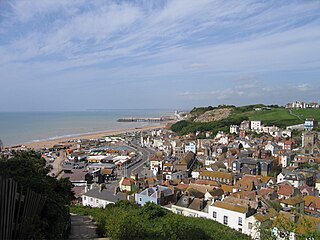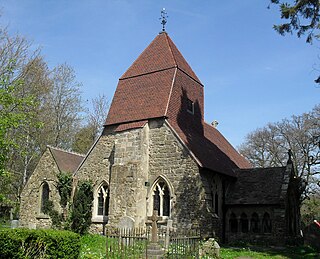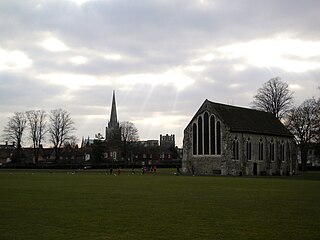
Beauport Park is a house near Hastings, East Sussex, England. It is located at the western end of the ridge of hills sheltering Hastings from the north and east.

Beauport Park is a house near Hastings, East Sussex, England. It is located at the western end of the ridge of hills sheltering Hastings from the north and east.
In 1862, [1] the Rector of Hollington Church found a huge slag heap on the site, evidence of probably the third largest iron works in the whole Roman empire. [2] In 1967, Gerald Brodribb, using divining rods, [3] and Dr Henry Cleere, an expert on ancient iron-working, began work that uncovered an impressively preserved bath house that was saved during the development of the golf course. [2] It was fully excavated in the early 1970s. Although it was scheduled as an Ancient Monument, at present it has no public access. Excavations in 1980 around the bath-house produced post-holes which seem to form part of a pre-Roman roundhouse. [4]
The first mention of Beauport Park is when General Sir James Murray is shown on local records as paying rates on some woodland. [5] He built the house between 1763 and 1766, [5] subsequently adding to the estate until it comprised about 5,000 acres (20 km2). Murray, who had served in Canada, named the estate after the Beauport in Canada. [5] It was Murray who started the tradition of planting rare and unusual trees on the estate. [5]
Following Murray's death in 1794, Beauport Park was then purchased by James Bland Burgess who served as Under Secretary of State for Foreign Affairs to William Pitt. [5] An obelisk which stands opposite the front of the hotel is in memory of James Burgess' second son, Ensign Wentworth Noel Burgess, who was killed in 1812 in the Peninsular War, aged 18, whilst leading an assault on the citadel of Burgos in Northern Spain. In 1821, James and his eldest son Charles changed their name to Lamb in honour of John Lamb, a benefactor of theirs. [5] An Ionic temple was built on the estate together with two life-size memorials which still remain. [5]
By 1860, the estate was owned by Sir Charles Lamb's son, Archibald, who leased the house to Thomas Brassey, a leading railway engineer of his day. [5] After Thomas Brassey died in 1870 the lease was inherited by his son who later became Lord Brassey. [5]
In 1923 a fire broke out and despite efforts by firemen from Battle and Hastings taking water from nearby ponds, the fire spread rapidly and the entire building was gutted. [5] The house was rebuilt in 1926. [5]
Little is known about the house during the period that follows its reconstruction in 1926 up until World War II, but at the beginning of the war, it was an underground citadel. It consisted of tunnels and chambers, built by the Canadian Army and was intended as a hiding place for a secret resistance army which would have fought behind the German lines following the expected invasion of Britain. [5] After the war, the house became a hotel. [5]
In 1983 the hotel was bought by Ken Melsom, David Robinson and Helena Melsom [6] and in 2005, Duncan Bannatyne opened a health club on the estate. Bannatyne went on to buy the hotel as well in 2007. [7]
The Beauport Park Archaeological Trust was formed in 1996. [1] [2] In 1999 it was the subject of a Time Team dig. [8] In 2007 the baths, set in five acres, were put on the market at £300,000 by Colin Henshaw of "Wild England". [9] As of 2013 [update] it is a Scheduled Monument at Risk and its condition was described by English Heritage as "Extensive significant problems" with "Deterioration - in need of management". [10]
The estate currently comprises the hotel, the health club, a riding school, a caravan park, a 186-acre (0.75 km2) golf course and 164 acres (0.66 km2) of surrounding woodland. [5]

Hastings is a large seaside town and borough in East Sussex on the south coast of England, 24 mi (39 km) east to the county town of Lewes and 53 mi (85 km) south east of London. The town gives its name to the Battle of Hastings, which took place 8 mi (13 km) to the north-west at Senlac Hill in 1066. It later became one of the medieval Cinque Ports. In the 19th century, it was a popular seaside resort, as the railway allowed tourists and visitors to reach the town. Today, Hastings is a fishing port with the UK's largest beach-based fishing fleet. It has an estimated population of 92,855 as of 2018.

Bath is a city and unparished area in the Bath and North East Somerset unitary area in the ceremonial county of Somerset, England, known for and named after its Roman-built baths. At the 2021 Census, the population was 101,557. Bath is in the valley of the River Avon, 97 miles (156 km) west of London and 11 miles (18 km) southeast of Bristol. The city became a World Heritage Site in 1987, and was later added to the transnational World Heritage Site known as the "Great Spa Towns of Europe" in 2021. Bath is also the largest city and settlement in Somerset.

East Sussex is a ceremonial county in South East England. Established in 1974 from the eastern half of Sussex, it is bordered by Kent to the north-east, West Sussex to the west, Surrey to the north-west, and the English Channel to the south. The largest settlement is the city of Brighton and Hove.

Burgess Hill is a town and civil parish in West Sussex, England, close to the border with East Sussex, on the edge of the South Downs National Park, 39 mi (63 km) south of London, 10 mi (16 km) north of Brighton and Hove, and 29 mi (47 km) northeast of the county town, Chichester. It had an area of 3.7 sq mi (9.6 km2) and a population of 30,635 at the 2011 Census, making it the fourth most populous parish in the county and the most populous in the Mid Sussex District. Other nearby towns include Haywards Heath to the northeast and Lewes, the county town of East Sussex, to the southeast.

Old Kent Road is a major thoroughfare in South East London, England, passing through the London Borough of Southwark. It was originally part of an ancient trackway that was paved by the Romans and used by the Anglo-Saxons who named it Wæcelinga Stræt. It is now part of the A2, a major road from London to Dover. The road was important in Roman times linking London to the coast at Richborough and Dover via Canterbury. It was a route for pilgrims in the Middle Ages as portrayed in Chaucer's Canterbury Tales, when Old Kent Road was known as Kent Street. The route was used by soldiers returning from the Battle of Agincourt.

Thomas Brassey, 1st Earl Brassey, was a British Liberal Party politician, Governor of Victoria and founder of The Naval Annual.

St Leonards-on-Sea is a town and seaside resort in the Borough of Hastings in East Sussex, England. It has been part of the borough since the late 19th century and lies to the west of central Hastings. The original part of the settlement was laid out in the early 19th century as a new town: a place of elegant houses designed for the well-off; it also included a central public garden, a hotel, an archery, assembly rooms and a church. Today's St Leonards has extended well beyond that original design, although the original town still exists within it.

Arthur Gerald Norcott Brodribb was a cricket historian and archaeologist.
The Classis Britannica was a provincial naval fleet of the navy of ancient Rome. Its purpose was to control the English Channel and the waters around the Roman province of Britannia. Unlike modern "fighting navies", its job was largely the logistical movement of personnel and support, and keeping open communication routes across the Channel.

Charles Dawson was a British amateur archaeologist who claimed to have made a number of archaeological and palaeontological discoveries that were later exposed as frauds. These forgeries included the Piltdown Man, a unique set of bones that he found in 1912 in Sussex. Many technological methods such as fluorine testing indicate that this discovery was a hoax and Dawson, the only one with the skill and knowledge to generate this forgery, was a major suspect.
The Bath Grounds is a historic recreational ground and cricket ground based in the town of Ashby-de-la-Zouch, Leicestershire. It is home to Ashby Hastings Cricket Club and Ashby Bowls Club. The grounds are subject to conservation area protection. and are designated a "sensitive area" in retained policy E1 of the most recent Local Plan.

Hastings Museum & Art Gallery is a museum and art gallery located in, Hastings, East Sussex, England. Established in 1892, it originally resided in the Brassey Institute, but moved to its current location in 1927. As of 2019 it had around 97,000 objects of local history, natural sciences, fine and decorative arts, and world cultures.
The Cateys are a UK award ceremony for the hospitality industry, first held in 1984. They have been described as the hospitality industry's equivalent of the Oscars. Recipients are nominated, selected and awarded by the industry through The Caterer magazine.
Wilson Noble was a barrister and Conservative Party politician in England who served from 1886 to 1895 as Member of Parliament (MP) for Hastings in East Sussex.

Gravetye Manor is a manor house located near East Grinstead, West Sussex, England. The former home of landscape gardener William Robinson, it is now a hotel and restaurant holding, in 2020, one star in the Michelin Guide, and is listed Grade I on the National Heritage List for England, its gardens are also Grade II* listed on the Register of Historic Parks and Gardens.

Church in the Wood, officially known as St Leonard's Church and originally as St Rumbold's Church, is an Anglican church in the Hollington area of the town and borough of Hastings, one of six local government districts in the English county of East Sussex. Although Hollington is now a large suburb, consisting mostly of postwar residential development, the church has stood in isolation in the middle of an ancient wood since it was founded in the 13th century—almost certainly as the successor to an 11th-century chapel. Restoration work in the Victorian era has given the Early English Gothic-style building its present appearance, but some medieval work remains. Legends and miraculous events have been associated with the church, and its secluded situation has been praised by writers including Charles Lamb. The church is a Grade II Listed building.

The Church of St Thomas of Canterbury and English Martyrs is the Roman Catholic church serving St Leonards-on-Sea, a town and seaside resort which is part of the Borough of Hastings in East Sussex, England. The present church, which combines a plain, unadorned Gothic Revival exterior with a lavishly decorated interior featuring extensive early 20th-century paintings by Nathaniel Westlake, is the third building used for Roman Catholic worship in the seaside resort. James Burton's new town of 1827, immediately west of Hastings, was home to a convent from 1848; public worship then transferred to a new church nearby in 1866. When this burnt down, prolific and "distinguished" architect Charles Alban Buckler designed a replacement. The church remains in use as the main place of worship in a parish which extends into nearby Hollington, and has been listed at Grade II by English Heritage for its architectural and historical importance.

Priory Park is a public park in Chichester, West Sussex, England, operated by Chichester District Council. It is situated in the north-east quadrant of Chichester City centre. The park is bordered by the medieval city walls to the north and east which are built upon the original Roman foundations. The park contains Chichester Castle and the Guildhall.

Bimini Baths was a geothermal mineral water public bathhouse and plunge in what is now Koreatown, Los Angeles, California, US. It was situated just west of downtown, near Third Street and Vermont Avenue. Bimini Baths contained a natatorium, swimming pools, swimming plunge, Turkish baths, a medical treatment department, and bottling works.